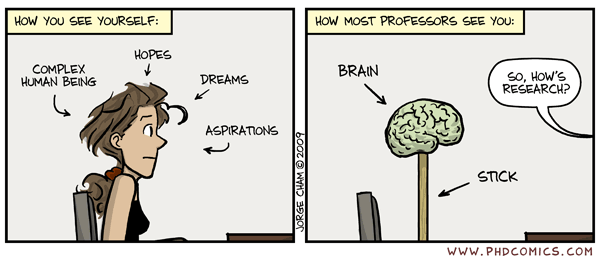Apply our problem solving method
Career Wise Menu
Learn problem solving skills: Consider Other Perspectives

- Learn to enhance your ability to consider situations from many points of view.
“I feel like my advisor puts more pressure on me than my other labmates. I don’t understand why she does this.”
“Online classes are difficult, and the professors still expect us to do the same work or more; the transition must be easy for them.”
“My advisor doesn't like my dissertation idea and keeps suggesting edits. He probably does not think I am ready for graduation.”
As a graduate student, you most likely have many demands and expectations placed on you. Your program, your faculty advisor, your family, and society are a few sources from which you probably feel pressure to perform.
You may understandably feel overwhelmed and frustrated when people in your life are demanding yet unsupportive. Perhaps they provide little constructive feedback or guidance yet also have high expectations. Are some people simply trying to make your life difficult or is something else going on? How can you get a handle on this?
Human relationships, whether personal, academic, or professional, are complex. Each interaction you have with another person is impacted by an unfathomable number of factors.
These may range from how your (and the other person’s) day is going to what your (and their) personal goals in life may be. Thrown into the mix of these personal moods and agendas are your own intentions and the assumptions people continuously make about each other.
Understanding others is key to effective interactions. The perspective-taking skills discussed in this module will provide you with tools enabling you to consider situations from many points of view.
REFLECTIONS: TEST YOUR PERSPECTIVE
What are you seeing in each of these pictures?

An old woman or a young woman?

A Sax player or a lady?

A face or a person with a thick jacket?
These are all exercises in perspective-taking. It’s an illustration of how the same thing can appear different to different people, and change at different times. You may look at one of these pictures and see one image and then within moments, another image becomes the focal point.
Your life circumstances also follow this logic. There are many ways to look at any one situation.
In an emotionally charged situation, you may often lose sight of the big picture. As a result, you tend to focus on your own experience in the moment and forget that others might approach the issue with different thoughts and feelings.
Simply put, perspective-taking is the act of considering what another person’s viewpoint could be in a given situation. It is actively imagining how someone else construes the event.
Perspective-taking is about “seeing their side” versus “feeling their pain.” Considering another person’s point of view helps you understand the issue more clearly.
Both perspective-taking (cognitive) and empathy (more emotional) are ways to understand the other person’s internal thoughts and feelings. Perspective-taking allows you to keep both your and the other’s interests in mind while interacting.
Additionally, if the other person thinks that you have acknowledged their perspective, they may like you more and believe that the two of you have more in common (Goldstein et al., 2014). It is no surprise, then, that perspective-taking helps significantly in negotiations, problem solving, and overall satisfaction with relationships (Longmire et al., 2018).
Here are some tips to help consider others’ perspectives:
- Consider their point of view. What shapes it?
- Other experiences?
- Different roles?
- Be curious about their views.
- Suspend judgement while listening to their point of view.
- Consider your own biases.
- How is your point of view constructed?
- Does bias interfere with understanding each other?
- How are you responding emotionally?
- Focus on the why.
- Focus on the why behind their feelings, thoughts, and concerns.
- Focus on the why behind your feelings, thoughts, and concerns.
- What can you learn from their point of view?
Even if you disagree, how does this expand your understanding of the situation from others’ perspectives?
Two methods of perspective-taking include:
- Imagining how the other person perceives a situation and how they feel about it
- Imagining how you would perceive the situation and feel about it if you were in the other person’s position
Both methods of perspective-taking facilitate a clearer understanding of the expectations others have of us. That understanding can lead to more productive relationships. Sometimes, however, imagining how you would feel in another’s situation might activate your own emotions and complicate the non-judgmental stance that perspective-taking entails.
Self-Test
I sent my advisor my poster abstract for review, 2 days before the conference deadline. She seemed frustrated and stated she was unsure if she would be able to get it back to me in time. I am concerned she does not like my work.
I thought it was a good abstract and would require minimal review, but her reaction makes it seem like it will require many changes. I did not have a chance to send it earlier and wanted support before the deadline. I know she is currently working on a grant proposal, but I also have other responsibilities.
In considering other perspectives, what are some factors you might consider?
- A. Advisor’s multiple roles/responsibilities (e.g., grant writing)
- B. Your own bias
- C. Emotional reactions (shared frustration due to time pressures)
- D. All of the above
A three-step approach to perspective-taking is outlined below. The steps involve gathering data on the other person’s perspective through careful observation and thoughtful consideration.
Take the following example:
You are at a research team meeting. Your labmate, Harpreet, sits through the meeting slouched in her chair with her head in her hands. The research team leader makes a comment about her recent decline in productivity. She explains that she has been sick lately and hasn’t been able to work much on the current project.
Harpreet remains quiet and tight-lipped the remainder of the meeting. After the meeting you see her in the hall. You explain that you recently had the same bug, and it helped you to stay in for a day and sleep it off. She shoots you a menacing look and storms out without saying goodbye.
STEP ONE: WATCH
Start by identifying and monitoring your own thoughts and feelings about a given situation. Not only does this help you focus and gain awareness, but it also helps you uncover subtle cues others provide regarding their thoughts and feelings. Possible cues can involve body language, tone of voice, and facial expression.
Harpreet’s body language:
- slouched position
- head in hands
- solemn facial expression
- glare in hallway
- removing herself from the room
STEP TWO: LISTEN
Remember that hearing and listening are not the same. Listen carefully to what the other person is saying explicitly and implicitly. That is, what are they directly saying, and what can you infer about their message from the way they deliver it?
In some cases, people will tell you directly what their viewpoint or perspective is. At other times, the message and meaning might be ambiguous, and you will need to listen just as carefully to what is NOT being said.
Harpreet’s explicit communication:
- She has been behind in work (according to the team leader)
- She has been sick (according to herself)
Harpreet's implicit communication:
- She was possibly upset by the advisor’s comment, as she remained silent after it was made.
- Her glare indicated that something about your remark in the hallway might have rubbed her the wrong way.
STEP THREE: SEARCH
With a better understanding of what is being communicated, you will now want to put yourself in the other person’s shoes.
- What might the other person have at stake in the situation?
- How might the situation appear from their standpoint?
- How are they affected by the demands placed on them?
- How might your actions affect them?
Try using the two methods described earlier in this module: imagine what the other person is experiencing, and imagine how you might experience it from their position.
Harpreet has at stake:
- Her standing with the research team (as she is behind in her work)
- Her health
- Additional responsibilities such as other school and family demands
In Harpreet’s case, she might:
- Feel embarrassed
- Be frustrated that she has fallen behind in work
- Feel that people are not supportive of her situation
- Be annoyed that you think you had the same bug, when hers is a chronic health issue
- Find your comment to be unhelpful or insensitive. In fact, your comment might have come across as, “Why can’t you get yourself together like I can?”
A next step in this hypothetical situation is to check in with Harpreet about whether or not you are accurate in your perception. In fact, the entire situation might have been avoided if you had asked Harpreet, “Hey, is everything OK? What is going on for you?” as opposed to offering advice. It is always best to go directly to the source for information.
Consider point of view when working with someone with a different cultural perspective. Individuals are shaped by their environments and by social and cultural factors.
These factors may include a person’s race, ethnicity, gender, sexual orientation, social-economic status, upbringing, etc. Our perspective is further influenced by our identities (e.g., student, mother) in a particular context.
Here are some tips to consider when engaging in multicultural perspective-taking:
- Consider their and your individual cultural influences in decision making (e.g., individualistic views vs. collectivist views).
- Consider differences in communication values (e.g., self-expression vs. harmony).
- Consider the specific context where you are interacting (e.g., power differentials, different roles and responsibilities).
- Consider differences in what is important and why it is important (e.g., research focused on giving back to the community vs. discovery research).
Being aware of another person’s point of view and their intentions and motivations is key to understanding their actions. Comparing your perspective with that of the other person may assist you in recognizing the difficulties you are facing from an objective standpoint. A small amount of understanding can go a long way in diffusing tension and laying the foundation for effective communication and problem solving.
Batson, C. D., Early, S., & Salvarani, G. (1997). Perspective taking: Imagining how another feels versus imagining how you would feel. Personality and Social Psychology Bulletin, 23(7), 751–758. https://doi.org/10.1177/0146167297237008
Galinsky, A. D., Maddux, W. M., Gilin, D., & White, J. B. (2008). Why it pays to get inside the head of your opponent: The differential effects of perspective taking and empathy in negotiations. Psychological Science, 19(4), 378–384. https://doi.org/10.1111/j.1467-9280.2008.02096.x
Gehlbach, H., Marietta, G., King, A. M., Karutz, C., Bailenson, J. N., & Dede, C. (2015). Many ways to walk a mile in another’s moccasins: Type of social perspective taking and its effect on negotiation outcomes. Computers in Human Behavior, 52, 523-532. https://doi.org/10.1016/j.chb.2014.12.035
Goldstein, N. J., Vezich, I. S., & Shapiro, J. R. (2014). Perceived perspective taking: When others walk in our shoes. Journal of Personality and Social Psychology, 106(6), 941–960. https://doi.org/10.1037/a0036395
Ku, G., Wang, C. S., & Galinsky, A. D. (2015). The promise and perversity of perspective-taking in organizations. Research in Organizational Behavior, 35, 79-102. https://doi.org/10.1016/j.riob.2015.07.003
Longmire, N. H., & Harrison, D. A. (2018). Seeing their side versus feeling their pain: Differential consequences of perspective-taking and empathy at work. Journal of Applied Psychology, 103(8), 894. https://doi.org/10.1037/apl000030
Ma-Kellams, C., & Blascovich, J. (2012). Inferring the emotions of friends versus strangers: The role of culture and self-construal. Personality and Social Psychology Bulletin, 38(7), 933-945. https://doi.org/10.1177/0146167212440291
Vignoles, V. L., Owe, E., Becker, M., Smith, P. B., Easterbrook, M. J., Brown, R., González, R., Didier, N., Carrasco, D., Cadena, M. P., Lay, S., Schwartz, S. J., Des Rosiers, S. E., Villamar, J. A., Gavreliuc, A., Zinkeng, M., Kreuzbauer, R., Baguma, P., Martin, M., . . . Bond, M. H. (2016). Beyond the ‘east–west’ dichotomy: Global variation in cultural models of selfhood. Journal of Experimental Psychology: General, 145(8), 966–1000. https://doi.org/10.1037/xge0000175
Wang, C. S., Lee, M., Ku, G., & Leung, A. K. Y. (2018). The cultural boundaries of perspective-taking: when and why perspective-taking reduces stereotyping. Personality and Social Psychology Bulletin, 44(6), 928-943. https://doi.org/10.1177/0146167218757453
Wu, S., & Keysar, B. (2007). The effect of culture on perspective taking. Psychological science, 18(7), 600-606. https://doi.org/10.1111/j.1467-9280.2007.01946.x
International Graduate Experience
Appreciation for advisor's assistance in transitioning to the US.
Experience as an International Grad Student
Challenges of being international and female, particularly with regards to an academic career and the choice to have children.
Hearing from Students and Having an Impact
The importance of giving back to students and making an impact in their future education and career choices.
Dealing with Assumptions and Accusations
Being accused of cheating and regrets about not being more assertive.
Sharing News of Pregnancy with Advisors
Departmental reactions to the choice to have children.
The Importance of Sharing Stories
The importance of hearing other people's stories.
The Role of the Dean in Fostering Progress at the Institutional Level
The importance of a good leader in setting standards for diversity, climate, an
Observations on Women's Safety (Part 2)
Discusses necessary precautions to take as a female student working late nights on campus.
Apply Problem Solving Side Menu
An Arizona State University project, supported by the National Science Foundation under grants 0634519, 0910384 and 1761278
Any opinions, findings, and conclusions or recommendations expressed in this material are those of the authors and do not necessarily reflect the views of the National Science Foundation. © 2021 CareerWISE. All rights reserved. Privacy | Legal



